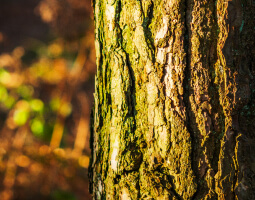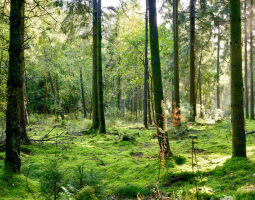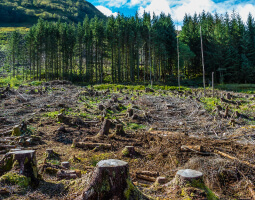Carbon Sequestration
The accumulation and retention of carbon within the trees, deadwood, litter and soil within a forest is a process called carbon sequestration. This process results in the carbon stock of a forest, i.e., the total amount of carbon on a site or defined area.
The carbon stocks of forests can vary greatly with tree species, age and management and are strongly influenced by soils and climate.
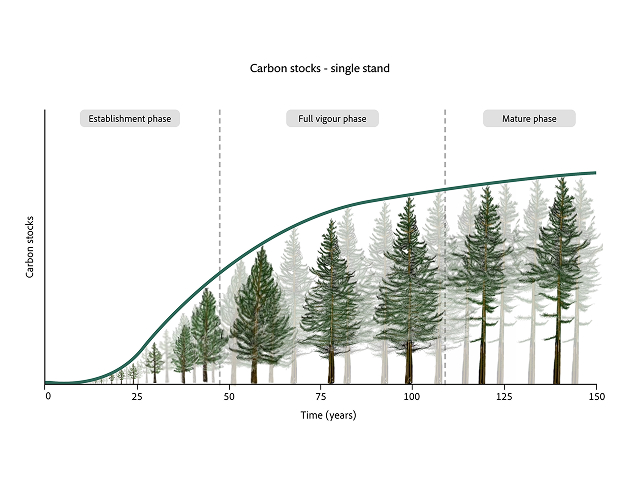
Click image to enlarge
Figure 1. An illustration of the change in total tree, litter and soil carbon stocks that can occur on an area of land by planting a stand of conifer trees. The example is for a ‘typical’ upland soil type such as a ‘gley’, with relatively low levels of soil organic matter before tree establishment.
Forest Carbon Dynamics
The rate of carbon sequestration in forests varies as trees establish, grow and mature.
After initial tree establishment, forest carbon stocks start to accumulate as the rate of carbon uptake through tree photosynthesis exceeds carbon losses through tree and soil respiration and plant decomposition.
This process continues as the trees grow, at an increasing rate until they reach the full vigour phase of tree growth. As trees reach maturity, their growth rate slows, and the rate of carbon accumulation declines (see Figure 1).
Between establishment and maturity, trees regularly lose needles, leaves and roots, and some trees may die. These processes add to the carbon stocks in deadwood and litter, though some carbon (and sometimes methane) is lost through decomposition. The amount of carbon that is transferred to the forest soil depends on many factors including the soil type, how long the soil has been under forest, and the previous land use (e.g. cropland or pasture). For newly created forests, the initial ground preparation practices can cause significant soil carbon losses, which can take time to recover (see our Establishing new woodland page for further detail).
Forests do not remove CO2 from the atmosphere and sequester carbon indefinitely. As forests grow older, eventually the rate of CO2 removed through photosynthesis is balanced by the CO2 returned to the atmosphere by plant respiration and decomposition, and the forest will reach an equilibrium carbon stock, (when averaged over a few years). The forest will then remain in balance unless there is some kind of disturbance, such as a harvesting event, or naturally occurring event such as a storm, fire, drought or disease outbreak.
The Impact of Harvesting
The modelled carbon impacts of harvesting an individual stand within a forest (Figure 2) is put into context with how harvesting impacts the overall carbon stocks of the whole forest (from its establishment), in Figure 3. In the example given, each stand is managed in the same way. A landowner could manage their land this way to ensure a constant supply of timber.
While harvesting will usually result in a direct loss of carbon stock from a forest stand, some carbon is transferred to the wood product carbon pool, some is transferred to deadwood and litter, some enters the soil, and some is lost as CO2 over time as plant material decomposes.
Figure 2 shows that across the landscape, the carbon losses of harvesting of mature stands can equal the rate of carbon sequestration in younger stands. Although the example is simplistic, the overall net effect is that the forest landscape can reach an equilibrium, stable carbon content.
This means that the carbon impacts of individual harvesting events should be considered in the context of the overall carbon dynamics of the forest landscape. Whether an area of forest land is on a trajectory to achieving a steady state carbon stock is dependent on various factors, including its age distribution and management history, including rotation length and thinning intensity. Forest owners considering changes to management need to consider the impacts of management interventions on this trajectory.
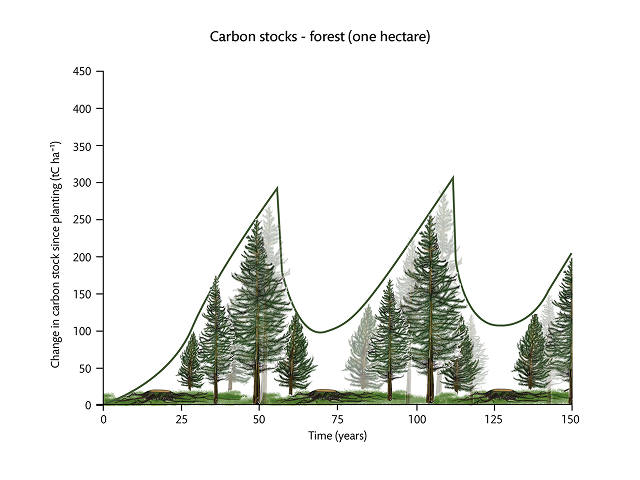
Click image to enlarge
Figure 2. An illustration of the change in total tree, litter and soil carbon stocks that can occur on a single area of land by planting a stand of conifer trees at the same time and managed in for production by clearfelling every 56 years, followed by replanting.
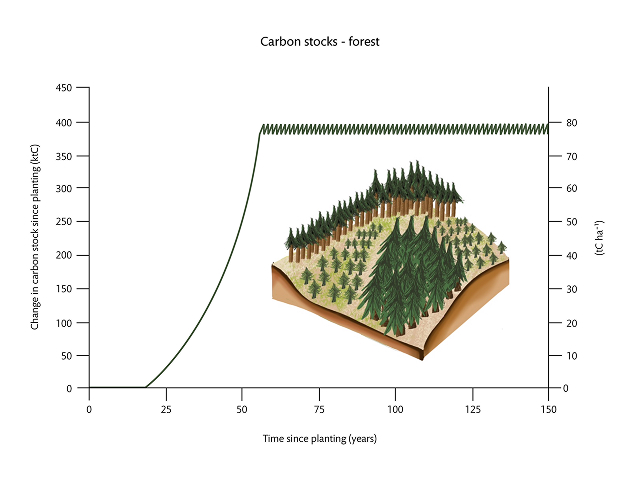
Click image to enlarge
Figure 3. An illustration of how the total carbon stock of a forest made up of many separately managed compartments of even aged Sitka spruce stands develops over 56 years.
Over short timeframes (e.g. up to 50 years), fast-growing productive conifers generally sequester the greatest amount of carbon and mitigate GHG emissions from wood product production. After longer periods of time, however, long-lived broadleaved species accumulate large above- and below-ground carbon stocks, making the carbon sequestration in the forest between the different woodland types more equal.
It is possible for the carbon stock to increase if, for example, a continuous cover or shelterwood system is adopted instead of a clearfell system, or if the site is restocked by more productive species, although in each case the possible impacts on carbon stocks elsewhere in the system (soils, wood products) need to be considered. There is some evidence that mixed woodlands can sequester more above-ground carbon than monocultures due to complementarity between species and overyielding, and are also generally perceived to have greater resilience to external factors and disturbances.
Carbon stocks could increase if forest management is withdrawn entirely, however this would reduce the potential for carbon to be stored in wood products and could increase the risk from natural disturbance events (e.g. wind damage), which could lead to a loss of carbon stocks.
It is also possible for carbon stocks to decrease due to changes to management, for example by either increasing the rate of timber removal through thinning, or more intensive harvests (see Carbon impacts of managing woodlands).


